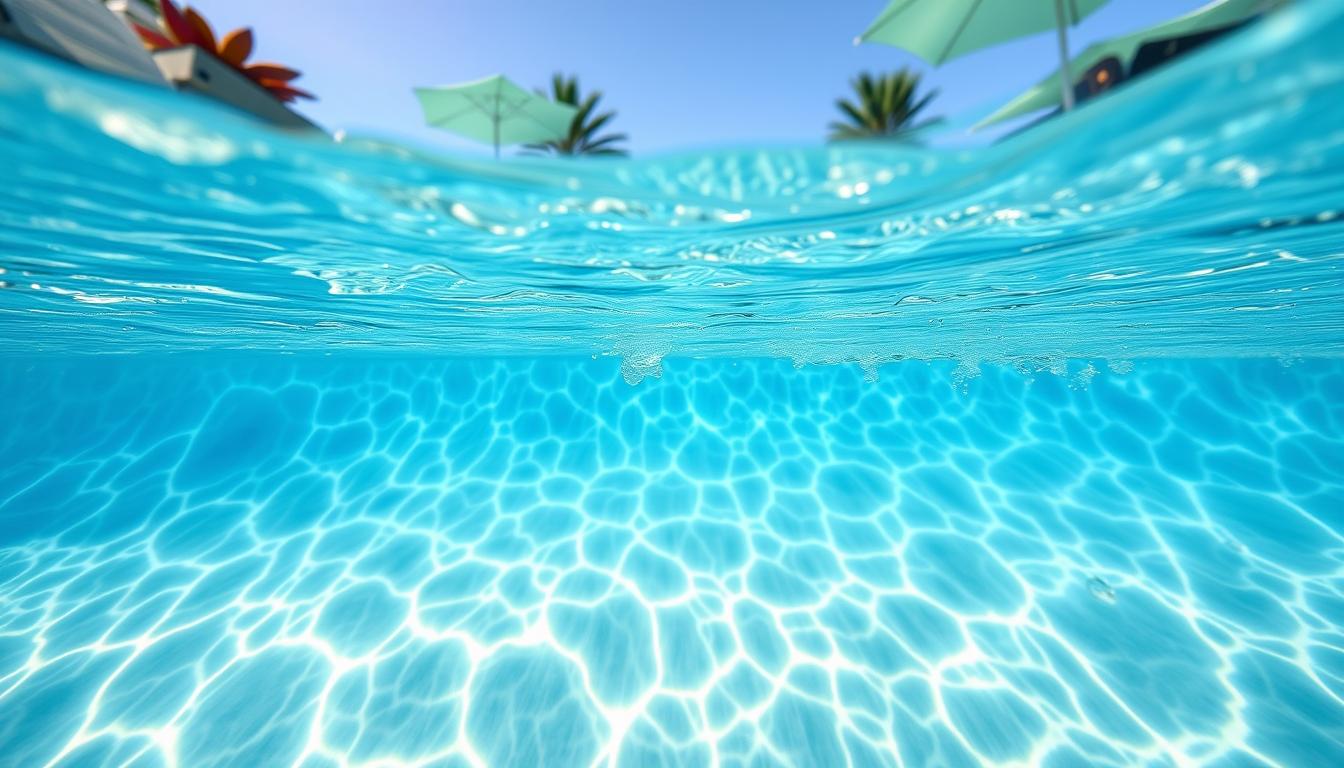
Pool owners often ask about shock clearing time. This varies based on pool size, water issues, and shock type. Let’s explore pool shocking and how to get crystal-clear water.
Shocking is vital for a healthy pool. It eliminates contaminants and restores water clarity. Many wonder when it’s safe to swim after shocking.
We’ll cover different shock types and factors affecting clearing time. You’ll learn how to shock your pool effectively. This ensures a sparkling oasis for everyone to enjoy.
Key Takeaways
- Pool shocking is an essential maintenance procedure that eliminates contaminants and restores water clarity.
- The pool shock duration depends on factors such as pool size, shock type, and water quality issues.
- Chlorine levels typically return to normal within 24-48 hours after shocking, but it may take a few days for the water to become completely clear.
- Different types of pool shock, such as calcium hypochlorite and non-chlorine shock, have varying impacts on pool water and chlorine levels.
- Proper pool shocking involves determining the right amount of shock, preparing the solution, adding it to the pool, and running the filtration system for optimal distribution.
Understanding Pool Shocking and Its Benefits
Pool shocking keeps water clean and safe for swimmers. It’s a vital part of pool care. Let’s explore how pool shocking works and why it’s important.
What is Pool Shocking?
Pool shocking adds a high dose of chlorine to the water. This kills bacteria and algae, and clears the water. It also breaks down chloramines, which can irritate eyes and skin.
Why Shocking Your Pool is Essential
Regular pool shocking creates a healthy swimming environment. It offers several key benefits for pool owners and swimmers.
- Eliminating harmful bacteria, viruses, and other pathogens
- Preventing algae growth and keeping the water clear
- Breaking down chloramines and reducing irritation for swimmers
- Removing organic contaminants like sweat, sunscreen, and body oils
- Maintaining proper chlorine levels for effective sanitation
Types of Pool Shock
There are three main types of pool shock. Each has its own benefits and uses. Choose the right type for your pool’s needs.
| Type of Shock | Description | Best Used For |
|---|---|---|
| Calcium Hypochlorite | Unstabilized chlorine, fast-acting, and powerful | Regular maintenance, heavy contamination, and algae treatment |
| Dichloroisocyanuric Acid (Dichlor) | Stabilized chlorine, slow-dissolving, and easy to use | Weekly maintenance and outdoor pools with high UV exposure |
| Potassium Monopersulfate | Non-chlorine shock, gentle on the skin, and doesn’t affect pH | Regular oxidation, removing contaminants, and accommodating sensitive swimmers |
Regular use of the right pool shock keeps your water clean. It creates a healthy and fun swimming environment for everyone.
Step-by-Step Guide to Shocking Your Pool
Shocking your pool keeps the water clean and safe for swimming. Follow these steps to shock your pool effectively. You’ll enjoy crystal-clear water throughout the season.
Determine the Right Amount of Shock
Calculate the shock amount based on your pool’s volume. Generally, use 1-2 pounds of shock per 10,000 gallons of water. The exact amount may vary by shock type and current chlorine levels.
Different pool shocks have varying chlorine levels. Calcium hypochlorite contains 50-80%, sodium hypochlorite 12.5%, and sodium dichloro-s-triazinetrione 40-50%.
Prepare the Pool and Shock Solution
Ensure normal water level and proper filtration before adding shock. Test water chemistry and adjust pH and alkalinity if needed. The ideal pH range is 7.2-7.6, while alkalinity should be 80-120 ppm.
Prepare the shock solution according to the manufacturer’s instructions. This may involve dissolving the shock in a bucket of water.
Add Shock to the Pool
Wear protective gear like gloves and goggles when adding shock. Distribute the solution evenly around the pool’s perimeter. Avoid direct contact with pool surfaces or equipment.
Shock your pool in the evening or at night. UV rays can quickly break down the chlorine in the shock.
Run the Filtration System
Run your pool’s filtration system for at least 8 hours after adding shock. This ensures even distribution of the treated water. Longer filtration helps eliminate bacteria, algae, and other contaminants more effectively.
Test and Adjust Water Chemistry
Test your pool water again after the filtration cycle. Ensure chlorine levels have returned to 1-3 ppm before swimming. Adjust pH and alkalinity levels if necessary to maintain balanced water chemistry.
Shock your pool weekly if you swim daily. If you swim less often, shock every other week.
| Type of Shock | Chlorine Level | Usage |
|---|---|---|
| Calcium Hypochlorite | 50-80% | Most common for chlorine pools |
| Sodium Hypochlorite | 12.5% | Liquid shock for chlorine pools |
| Sodium Dichloro-s-triazinetrione | 40-50% | Stabilized shock for chlorine pools |
| Potassium Monopersulfate | Chlorine-free | Used for saltwater pools |
How Long for Shock to Clear Pool
After shocking your pool, wait at least 24 hours before swimming. This ensures chlorine levels return to a safe range. The waiting time may vary based on pool size and initial water quality.
Test chlorine levels using a reliable pool water test kit. Safe swimming requires chlorine levels between 1-4 ppm (parts per million). Don’t enter the pool if levels exceed 4 ppm to avoid health risks.
High chlorine levels can cause skin and eye irritation. They may also discolor clothing and swimwear. Ingesting water with high chlorine can lead to illness.
Wait for the water to become clear before swimming. If the pool remains cloudy after 48 hours, run the filtration system continuously. This may take two to three days to remove algae and debris.
If water clarity doesn’t improve after a few days, seek professional help. Specialized algaecides might be needed to restore the pool’s pristine condition.







